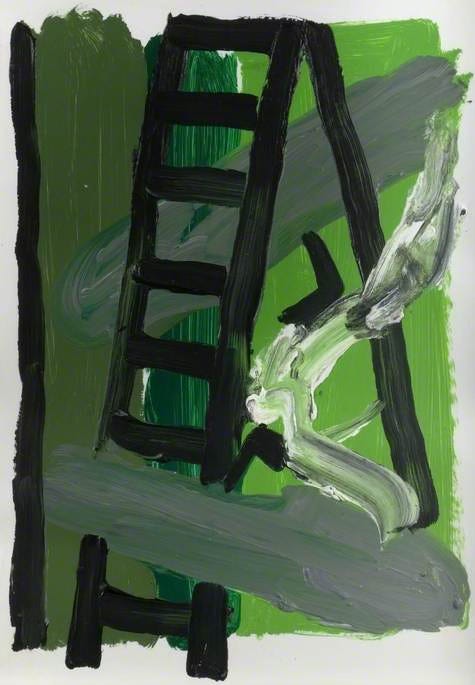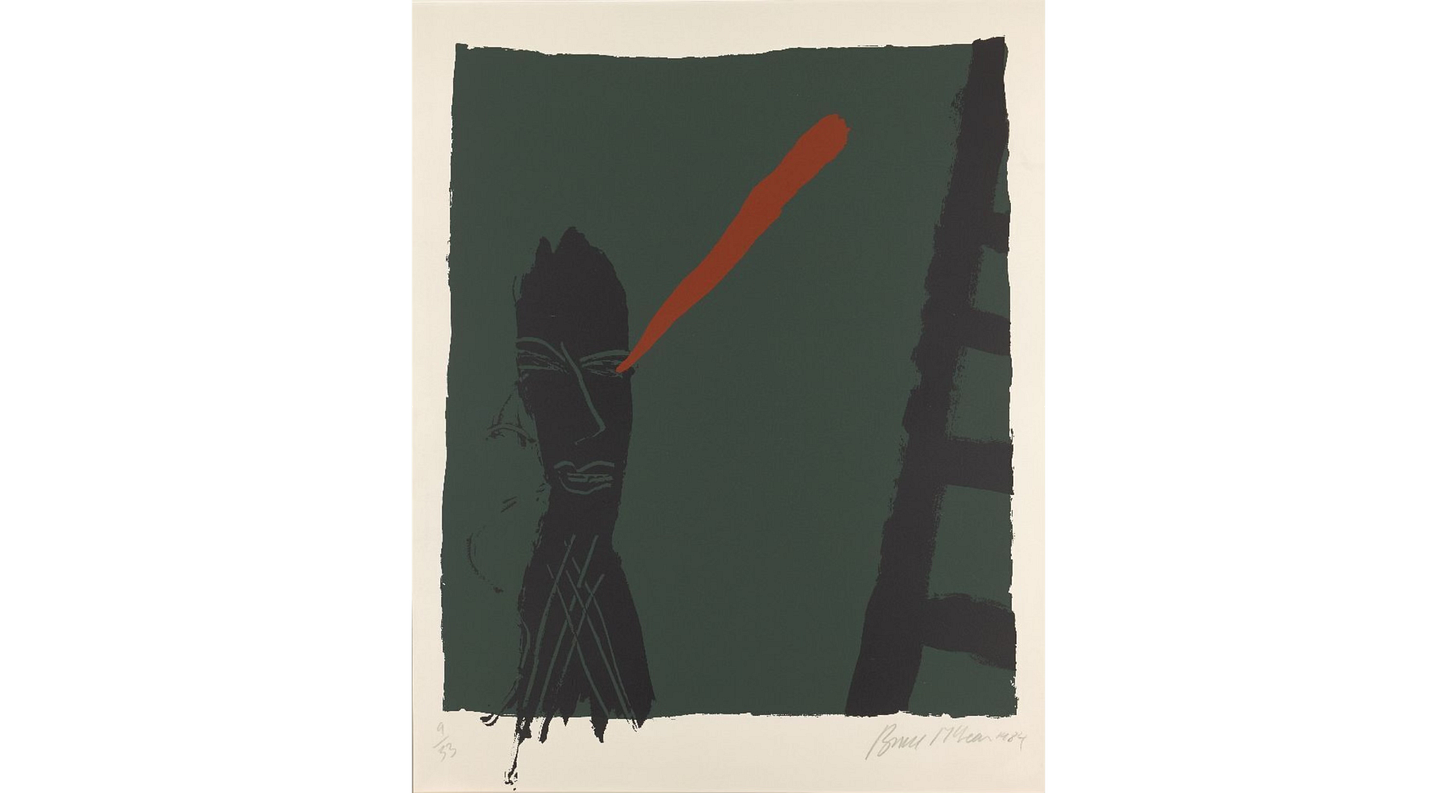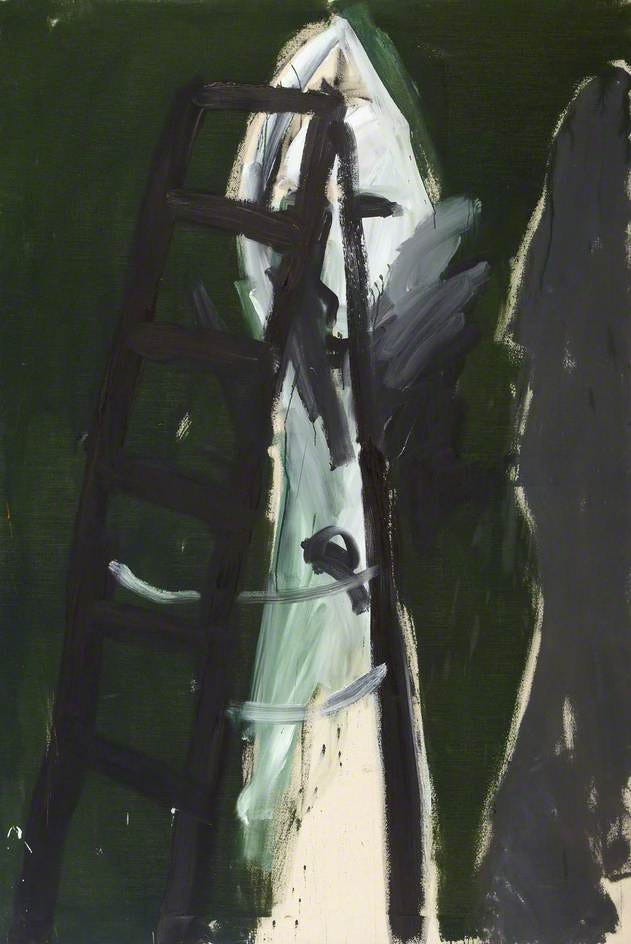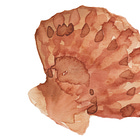Ladders to Heaven
I walk up eighty-nine steps to my disability theory class every Monday and Wednesday. One day, I start my ascent just as the elevator does and find myself cresting the eighty-ninth step as the elevator reaches the fourth floor. The stairs are harder but just as fast! Fist pump. The efficiency and exercise give me a sense of satisfaction, strength, and capability. I walk into class slightly breathless, but I easily hit my step goal for the day.
Disability theory, I learn, begins with a basic assertion that this world has, through social expectations, assumptions, and design, disabled and disregarded many individuals who fail to meet an often unspoken social standard.1 Our world is constructed around what a typical or “normal” individual should be able to do. We do not often question these standards because they seem to be the natural way of the world. It means we, through limiting access to spaces, further disable individuals who need accommodations. For example, we may be so accustomed to able bodies as the norm that we are blind to the need for wheelchair ramps or braille in our buildings and classrooms.
It means that we may use “blind” as a metaphor for ignorance, which I just did in the previous sentence. I didn’t notice the inherent problem of this metaphor or how often I used it until I sat in class next to my friend Rebekah. As a child, Rebekah loved to swim and dive, but she was born with a weak retina attachment. Over time and compounded by swimming, Rebekeah eventually lost her sight. She is now raising seven children and going to graduate school, all while fighting for access to readings, for an accessible online learning platform, and to be seen as relevant in the classroom.
Disability theorists and activists heartily disavow this “ideology of ability” and the standards of normalcy. They advocate being recognized as fully human even though they may require accommodations. Who, they ask, defined what abilities were “normal” for the “average” human? The answer is dispiriting: Our standards for normalcy can be traced to a group of statisticians in the mid-1800s who were part of the eugenics movement, advocating for a statistically normed population free of “inherited diseases” by means of “sterilizing the disabled.” The result of applying statistics to human bodies is often that “people with disabilities [are] thought of as deviants.”2 Historically, people with disabilities have found themselves set aside, put away, cleansed from public spaces, and distanced from those deemed “fit.”3
Perhaps this explains why I race to stay fit. I race to keep up with what I think I should be able to do as a fit human: easily climb eighty-nine steps. And I side-eye those taking the elevator, content that I’m ahead of the curve.
For a class assignment, I decide to examine the prodigal son. Hasty and greedy, he wanted the elevator express pass to independence, and his father gave it to him. But he only found a wandering path to emptiness in a lowly swine trough. When I examine my life, I’ve stayed close to my spiritual home like the older brother in the parable. He was so capable, it seems. He was an undeviating, take-the-stairs kind of son. And I see myself in him: I take the stairs because I am a take-the-stairs kind of girl. I’m going to outrun and outlive illness, ill health, and poor genetics. I’ve always been one to try and check the boxes. Read scriptures. Check. Pray. Check. I see myself in who I imagine the older, obedient son would be as a parent. Please God, don’t let my children wander to the swine trough. Please, God, let them be able, faith-filled, and box-checking children.
As I apply the lens of disability to this most familiar of parables, however, I experience a few harrowing realizations:
Often, I am a statistician of faith, and my perspective is eugenic. Unknowingly, I’ve been holding an ideology of gospel ability over myself and others. Deviations from the norm of faith are unwelcome, sinful. I find myself categorizing and counting my steps. I even, admittedly, find myself categorizing the steps others take or don’t take. Wandering and winding don’t fit nicely into the covenant path narrative I’ve planned out for myself and for my children. I realize that, in some ways, I construct my faith around its own kind of ideology of ability. Who am I disabling or discounting in the process?
I can explain what I mean with another familiar gospel image: a ladder. When I was young, some well-meaning missionary or Primary teacher taught me about the mortal pit we are all in. In this pit there is a ladder—each rung we step up brings us closer to God. Faith, repentance, baptism—each rung rounds into the arches of our feet as we press onward and upward out of the pit. At the top of the ladder, they say, there is still a gap to conquer before we can extract ourselves. After all we can do, there is still some distance to overcome.4 Thankfully, they teach, Jesus can reach down—just far enough and only far enough—to extend a hand to us at that top rung and pull us out. We must do our part to get to that top rung.
But what if I cannot reach the top rung? What if someone I love cannot reach the top rung?
The 2022 Come, Follow Me manual ties this gospel ladder back to the Old Testament prophet Jacob. Citing President Marion G. Romney, it says, “Jacob realized that the covenants he made with the Lord . . . were the rungs on the ladder that he himself would have to climb in order to obtain the promised blessings.” Certainly, covenants are essential and available to all, and this is a fine interpretation of this scene; however, with the lens of disability theory in place, I read Jacob’s dream scene differently now.
Jacob leaves home under the pressure of an angry brother and a birthright bestowed under suspect circumstances. When he arrives at a “certain place,” he pulls up stones for a pillow and sleeps. In his dream, a ladder appears that reaches heaven. But there is no mention of Jacob climbing the ladder, only “angels of God ascending and descending on it” (Gen. 28:12). In this dream, Jacob isn’t commanded to do anything; he is blessed, and the land is blessed. “I am with thee,” God says, “and I will keep them in all places whither thou goest, and will bring thee again into this land; for I will not leave thee, until l have done that which I have spoken to thee of” (28:15). It seems that Jacob’s dream is less about the covenants Jacob will keep by climbing a ladder and more about God, the kinds of promises God makes, and how God will keep those promises: he will be with Jacob always, it seems to say, wherever he finds himself. God will descend the ladder and send angels down to help us on our way.
When Jacob awakes, he is astonished because he realizes “this is none other but the house of God, and this is the gate of heaven. . . . Surely the Lord is in this place; and I knew it not” (Gen. 28:17, 16). What is “this place”? Of course, it could be Beth-el, Jacob’s name for the city of Luz. But it could also be earth, mortality, the pit in which we all find ourselves. And, yes, sometimes mortality feels like a pit—muddy, slippery, unforgiving, rocky, tiresome. I think Jacob may have been feeling the mucky sides of his own mortal pit just prior to his dream. However, what if Jacob was astonished because this dream appears to suggest that this mortal pit is also where God and angels are found? God has just reminded Jacob that he would be with him “in all places” (28:15). Perhaps that is why Jacob, shaking his head slightly in wonder, says of the place, “This is none other but the house of God” (28:17; emphasis added). God will meet us here, in the muddy wrestles, the wanderings and windings of mortality, making this place sacred.
What if the stones Jacob set for a pillar are a reminder that the nights we sleep on rocks and can’t quite pull up our “able” bootstraps are not always deviant but where we encounter the divine? What if the ladder is a symbol of how Christ would later make his descent “below . . . all” to sanctify us weary souls? (D&C 122:8). Because a ladder would be impossible for anyone without an able body to climb. And though it is just a metaphor, I think it matters if I read that symbol from the seat of a wheelchair or from a spiritual place far, far away from that top rung.
When broadly applied to the gospel, an ideology of ability might mean no prodigal sons, no empty chairs at any celestial table—and no wheelchairs, either. Perhaps it means we should run up swiftly toward the norm of an obedience that doesn’t need to rely on Christ or anyone else. No wandering or winding, just a straight-up ascent to firmly place an unmuddied hand in Christ’s with an able grip. Sometimes, I find myself believing that is what the gospel really is—a Christ-less ascent to reach heaven. But disability theory has me rethinking the metaphor.
One day in class, our discussions turned to heaven. Daniel, a student who has spinal muscular atrophy (SMA) and is in a wheelchair, suggests that celestial glory for him doesn’t mean that his physical body will be healed to perfection, that he will in that future day suddenly jump out of his wheelchair and kick it to the curb. For him, celestial glory means that the body of Christ—our divine community—will be healed. We will no longer pray that he will miraculously be able to meet our physical standard but that we will learn to make room for him, to love him as he is. In Daniel’s mind, celestial means a community of accommodations offered without a begrudging hand or comparison; it means fewer side-eyes from all those energetic stair folk. Transformation will surely come, but not in the way we might expect.
Elder Uchtdorf teaches something similar to Daniel’s reimagining of the celestial kingdom when he compares us all to prodigals in his October 2023 conference address. “Who among us,” he says, “has not departed from the path of holiness, foolishly thinking we could find more happiness going our own self-centered way?” Said another way, we are all spiritually disabled, but that’s not to say we are deviant and sinful. Might it instead mean that we will all confront disabling realities, and it is in those realities we encounter God and his angels ascending and descending to meet us? As God said to Jacob, “I will keep thee in all places . . . I will bring thee . . . [home]” (Gen. 28:15). And could that new celestial home perfectly accommodate every kind of path and every kind of traveler who arrives?
We have all wandered—in different directions and different ways. We may like to think, as I do taking the stairs, that we are capable and checking all the boxes, but that kind of thinking positions us squarely in an ideology of ability paradigm. And from the box of ideological ableism, we can’t see the curves that, though wandering, lead us home. We are all prodigal—boxed or curved—and we all cry out for accommodation.
Applying a lens of disability to the gospel introduces some friction, however. Is the Atonement of Christ about meeting us where we are or about lifting us up to where he is? Are covenants accommodations suited to our ability or do they demand something more, transforming our ability to meet the demands of perfection? Stripping away the ideology of ability here is not a free pass to disobey—rather, it is a recategorization of the gospel norm to mean a wholehearted and ongoing reliance on Christ. Our covenants with God become accommodations adapted to the “weakest of all saints” (D&C 89:3) that make wastelands—like Beth-el or the nadir of our suffering—hospitable dwelling places, and they demand more of us and transform us. I don’t think it can be reduced to anything less wonderfully complex. It allows for Daniel’s vision of a celestial community that no longer seeks to change his ability to meet the physical norm but changes the expectations of what ability looks like. It changes how we expect or imagine others might be on the path, including ourselves and those closest to us. With this recategorization, a connective vulnerability can take root. Instead of being focused on my narrow vision for the covenant path, I turn away from judgment and welcome others on the path—no matter their pace, their stops and stutters, their backward glances. The bell curve of humanity is flattened, and we are only truly “disabled” if we eschew Christ completely.
In my disability theory class, I learn that there are many tools we don’t often think of as accommodations. A chair, for instance, is an accommodation for those who can’t stand all day. Stairs are an accommodation—a way to get from the ground floor to the fourth floor. Elder Uchtdorf reframed humanity as prodigal and in need of a way home, and this realization helped me see that what I viewed as simply necessary was its own kind of accommodation.
I still take the stairs, but I carry a little less pride as I ascend. As I watch Daniel and his wheelchair enter the elevator, as I sit by Rebekah as she uses her assistive technology, I see us all using accommodations suited to our needs.
Much to my satisfaction, the 2024 Come, Follow Me manual has slightly shifted the ladder and pit analogy. In this new iteration, Christ is in the pit with us, and he helps us climb the ladder. But as I have lived my life, I have slowly perceived that, for me, Christ is not simply helping me up the ladder; he has slung me over his shoulder. Without begrudging this assistance, he carries me up the ladder rungs on his back. He is, in fact, the ladder. He descends to suffuse this mortal wrestle with grace and mercifully enables me to shake my head in astonishment and say with Jacob, This is none other but the house of God . . . This is none other than the work of God.
Kirsten teaches first-year writing for BYU. Her research and writing interests include faith, spirituality, motherhood, the environment, and education.
Art by Bruce McLean
KEEP READING
POETRY
BOOK CLUB
Tobin Siebers, pioneer of disability theory, writes “Disability is not a physical or mental defect but a cultural and minority identity. To call disability an identity is to recognize that it is not a biological or natural property but an elastic social category both subject to social control and capable of effecting social change.” Tobin Siebers, Disability Theory (University of Michigan Press, 2008), 4.
If you are uncomfortable with the parallel being drawn between disability and sin, I am too; however, historically, this is exactly the explanation used for many disabled individuals. Lennard Davis writes, “The conflation of disability with depravity expressed itself in the formulation ‘defective class.’” See Lennard J. Davis, “Introduction: Disability, Normality, and Power,” in The Disability Studies Reader, ed. Lennard J. Davis (Taylor & Francis Group, 2013), 1–14. Emphasis added. In the New Testament we encounter this same conflation: “Who did sin? This man or his parents?” (John 9:2)
See, for example Jennifer Senior’s account of an aunt who was barely acknowledged during her lifetime because of her disabilities. Jennifer Senior, “The Ones We Sent Away,” The Atlantic, August 7, 2023.
I believe that 2 Nephi 25:23 has been misinterpreted. The emphasis is typically placed on our own efforts. But when we read this clause in the context of the entire verse, Nephi is laboring diligently to persuade his children to rely on Christ, to believe in him. This is not to downplay our own efforts; rather, it is to shift our energy toward leaning on and learning from Christ.












So Beautifully written and read🙏
Thank You for opening my eyes to such Holy Possibilities 🌷
Thank you. So many paradigm shifting insights.